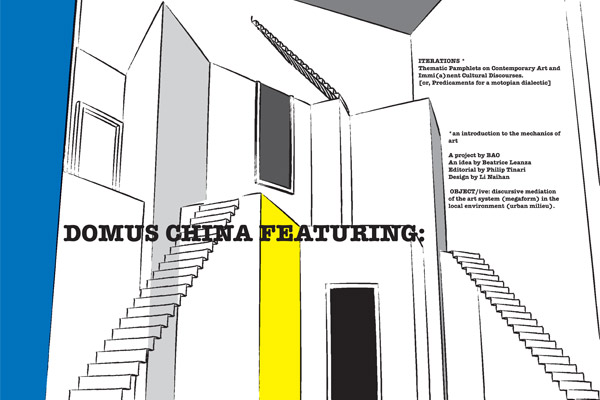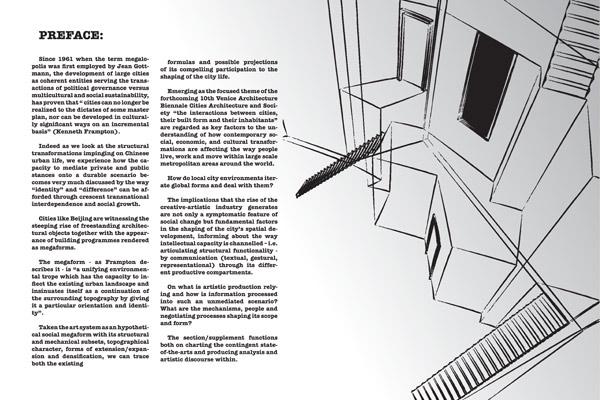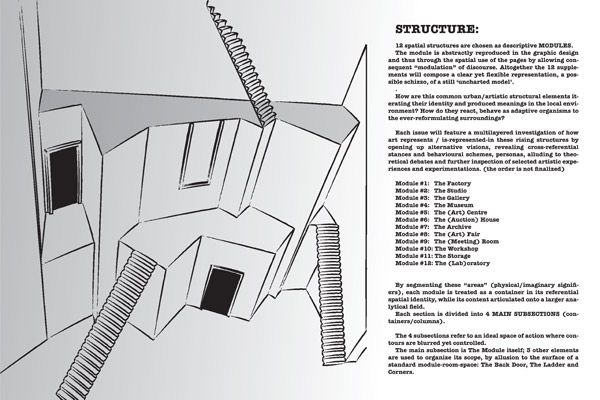A mini magazine for Domus China
May 2006
Project proposal for DOMUS China magazine: a special year-long monthly insert titled Iterations©, drawing upon local spatial modalities and the artistic system
From our proposal:
Emerging as the focused theme of the forthcoming 10th Venice Architecture Biennale Cities Architecture and Society, “the interactions between cities, their built form and their inhabitants” are regarded as key factors to understanding how contemporary social, economic, and cultural transformations are affecting the way people live, work and move within large-scale metropolitan areas around the world. How do local city environments iterate global forms and (alternatively?) deal with them? The implications of the rise of creative industries in China is not only a symptomatic feature of social change but a fundamental factor shaping the city’s spatial development, informing the way intellectual capacity is channeled (textual, gestural, representational) through its different productive compartments.
Each section is realized as an actual model, a charted 3-D projection of all the collaborations initiated throughout. At the end of one year Iterations will be both a precious archive and a source for a multimedia exhibition, displayed on the basis of the design realized for the magazine and articulated through its embedded theoretical implications.
Structure ::
MODULES :: each issue will feature a multilayered investigation of how art represents/is-represented-in these rising structures by opening up alternative visions, revealing cross-referential stances and behavioral schemes, alluding to theoretical debates and allowing further inspection of selected artistic experiences.
Module #1 :: The Factory
Module #2 :: The Studio
Module #3 :: The Gallery
Module #4 :: The Museum
Module #5 :: The (Art) Centre
Module #6 :: The (Auction) House
Module #7 :: The Archive
Module #8 :: The (Art) Fair
Module #9 :: The (Meeting) Room
Module #10 :: The Workshop
Module #11 :: The Storage
Module #12 :: The (Lab)oratory
Each section is divided into four main subsections (containers/columns). The four subsections refer to an ideal space of action where contours are blurred yet controlled. The main subsection is The Module itself; three other elements are used to organize its scope, by allusion to the surface of a standard module-room-space: The Back Door, The Ladder and Corners.
THE FOUR SUBSECTIONS ::
- The Module :: is a spatial identity for curatorial output. As the main body of the section, it bridges statements by different cultural players to propose representations of their commitment/attitude to the proposed area of analysis. It will allude to the given structure (e.g. The Factory) by articulating its strictly textual borders and will propose variations onto its function within the system. Examples of texts include: artists’ works, projects, curators’ notes, written and visual narratives.
- The Back Door :: is a space for unasked questions and relevant answers. It is envisioned as an imaginary dialogue in the form of a short interview, a statement, or an artist’s presentation of an idea. It is an ambiguous threshold, an entrance, an exit, a fake wall. Behind it anything can be concealed: a black hole, a person, a neighboring room, an inflammable fantasy, a repressed angst. It is thus the end of the mental and physical space we inhabit.
- The Ladder :: is a bridging tool. It is a subsection where a special artistic project is presented for Domus and co-produced with the artist’s representative gallery. Each section will thus have a featured guest gallery (national or international), which will allow a collaborative contribution to the section. (This will also generate revenue for the project, as galleries will pay to use this platform as they would a traditional advertisement.) It stands out from within the space to connect it to another module, whatever its direction, orientation, length or appearance.
- Corners :: define the amplitude of a space. As standpoints they withdraw different and possible angles of analysis onto the selected theme. It will be structured as a composite column invoking chronicles, personae, facts and unheard-of dialectics around contemporary art put in historical/social perspective. Each Corner will feature a specific theme, framed in relation to the given module.
PROPOSED CORNERS ::
1_ Gossip
2_ The Domestic Market
3_ Manufactured Personas
4_ Explicitly Chinese Imagery
5_ Missed Moments and Lost Souls
6_ Real Estate
7_ Indigenous Curators
8_ Basements
9_ Inspections
10_ Vestiges of Orientalism (The Rise and Fall of the Survey Show)
11_ Representation, The Significant Other
12_ Schizopolis



